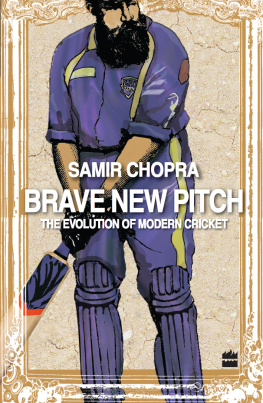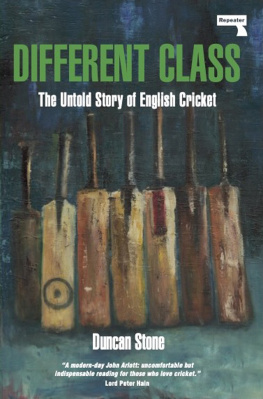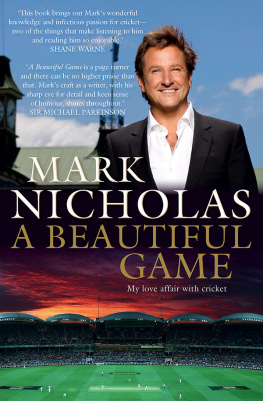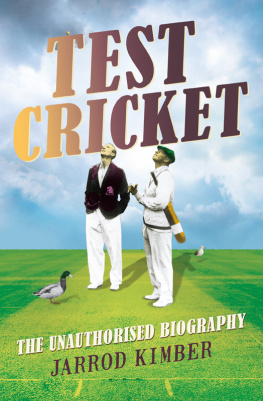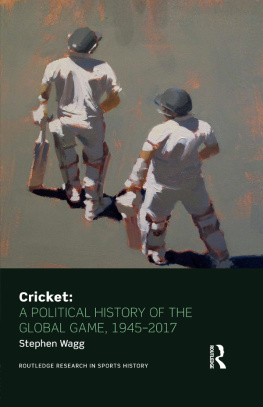
Brave New Pitch
The Evolution of Modern Cricket
SAMIR CHOPRA

Dedicated to Papa and Mukesh Mama, for making cricket romantic, always

I n July 2008, Mahendra Singh Dhoni, Indian wicketkeeper and future captain, opted out of a Test series in Sri Lanka claiming overwork and fatigue. Dhonis remarks sparked controversy among those who remembered his declining Test duty for the nation, but all he had done was draw attention to the truth that there were new paymasters in town, likely to skew priorities in a manner already visible to all.

Change, supposedly, is the only invariant. This quasi-adage rings especially true in cricket which, while often termed a charming bastion of conservatism, has morphed over the years as colourfully as a chameleon and as bewilderingly as the shapeshifters of ancient mythologies. Modern cricket bears as much resemblance to the village green game of the nineteenth-century as the jet airliner bears to the horse-drawn buggies that clattered down roads in the years gone by. Predictions and prognostications in cricket are thus a perilous business.
Still, cricket shows in its continuing evolution and current dynamics, the possible outlines of its future configurations; where cricket might proceed in the years to come may be revealed by an examination of its tumultuous present and its recent most important changes. Crickets form, whether the action on the field, or the machinations off it, will change; given the incessant flux of the sporting worlds political economy, and indeed, crickets own history, it would be foolish to imagine a perennially static game. The most important drivers of this transformation are likely to be a familiar combination: the fans, the administrators, the players, and the broader social-economic-technical home the external world provides; the game will continue to act as a lens, prism and mirror for these embeddings.
A variety of forces have shaped crickets recent dynamic evolution: political, via the arena it provides for the clash of nationalist aspirations; technical, via the radical changes the media has wrought, starting from Kerry Packers televised revolution and continuing on to todays utter dependency on television rights deals, the cricket channels on YouTube, the effervescent community of cricket bloggers that provides the best writing on the game, the Twitter feeds that led to the sinking of Lalit Modis fortunes as IPL commissioner, and continue to embarrass any player foolish enough to fire off one hundred and forty intemperate characters; and economic, via the change in labour relationships made possible by Kerry Packers World Series of Cricket (WSC), the Indian Cricket League (ICL) and the IPL, as well as contemporary work patterns that make the shorter game, the day-night Test, the impatience with the loss of time in a Test, realities that drive the game into ever-new directions.
Crickets current state of ferment often signals encounters of thesis and antithesis, in the contemporary clashes between Twenty20 tournaments and Test and first-class cricket, between the Anglo-Australian axis of Old Cricket Power and the Board of Control for Cricket in India (BCCI), encounters that require the constant engineering of syntheses satisfactory to those interested in crickets ultimate welfare. Some of crickets future is justly feared; some envisaged changes promise to transform the game into a generic accompaniment to the mass-produced entertainments of our times. Cricket has maintained a steadfast heterogeneity from the world of sport, sometimes risking marginalization, sometimes risking classification as not-modern; the loss of this distinctness, this cricketing culture, deserves a better coda, if one is necessary, than an undignified, rushed, showing of the door.
But crickets future form could also confound the Cassandras, in being genuinely rich and exciting in a way that caters to the changing tastes of the worlds fans and players, that appropriately utilizes the avenues opened up by a new media world, that sees its limited-overs versions not as parasites but as genuinely productive and enriching symbionts. This future does not require one formats prosperity to cost the demise of another; rather it requires an ecological balancing, a mix of appropriate prioritization, scheduling and incentivizing by administrators, players, and media rights holders alike. This non-competitive future for crickets different formats requires all concerned to bring both pragmatism and idealism to their deliberations and machinations for crickets next steps.
Crickets longevity is a function of its commanding a loyal following that has produced a rich, complex set of traditions. These are not to be overturned lightly. In particular, Test cricket, a marvellous exception to most things sporting, in its refusal to embrace modernity, its embrace of ambiguity in its results, and the prime underwriter of the rich fount of fan fantasy crucial to crickets construction of legends, deserves respectful care to shepherd it through the rough seas it is currently navigating. Test cricket needs not just public avowals of respect and support, but concrete safeguards; not a constant public berating for failing to entertain but rather, an acknowledgement of its hard-won pleasures, much as one might defend the tome-like novel against the comic book. To do so is not to denigrate the comic book; it is merely to point out the novels distinct pleasures.
Thus, crickets possibly-rich future needs an infusion of a judicious blend of conservative and revolutionary visions; in this book, I will often take turns at adopting their perspectives. The conservative is sceptical of poorly managed, destructive experiments; the latter welcomes the experiment, even if destructive. A classic statement of the conservative position is, More money in cricket is a good thing providedprofessionalization is responsibly managed. That means making changes conservatively and, crucially, resisting the impulse to trade in the integrity of the game for revenue. The revolutionary position appears implicitly in fervid hopes that the IPLand leagues like itgrows in leaps and bounds, displacing international Test cricket as variants of the IPL squat squarely over the cricketing landscape.
Such calls for moderation, for tightrope walking of the highest order, are justified because no other game in the world seems to face a crisis, even if possibly creative, quite like the one cricket does today; no other games community is engrossed in a debate about the possible overturning of centuries long tradition in favour of a new format and organization that bring a new understanding of its most basic notions. No other game appears to have its fortunes tied so closely to the economic and sporting health of one participant; no sport is bankrolled to quite the same extent by one entity. That dependency has already dramatically skewed modern cricketing conversations; like all dependencies, it breeds charges of arrogance, cultivates resentment and demands responsibility; it will continue to be the most important factor in all discourse about cricket for the foreseeable future.
It is contemporary common wisdom to describe world cricket through the prism of the rise to sporting and economic power of Indian cricket, the Indian cricket team, the BCCI, and the IPL. These entities are not identical; their conflation can be both edifying and problematic. But one or the other will persist in remaining front and centre in any discussion on cricket today. Most particularly, thanks to the IPL, to attempt a description of cricket at this juncture of the games history while ignoring the possible move from nation-based Test and one-day international cricket to global franchise-based Twenty20 cricket is to feign not having noticed the proverbial eight-hundred pound gorilla. The changes that franchise-based cricket promises are radical in a way that does justice to the etymology of the word, for they go to the very roots of the game as its fans know it; both the initial indictments of, and the hosannas paid to, the IPL revealed the deepest fears and the most extravagant promises of franchise-based cricket. The Twenty20 league represents the logical culmination of a drive always present in cricket: the eager, bustling, commercial sensibility that has jostled for space on crickets stage with its other, more staid, actors. But former jostlers were content to share the limelight; this new upstart threatens to buy the theatre company as well.
Next page
